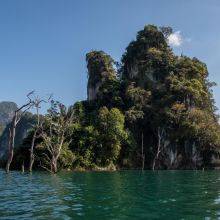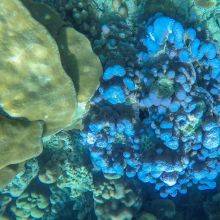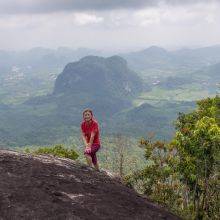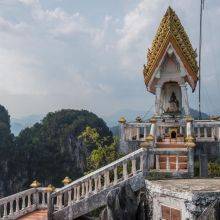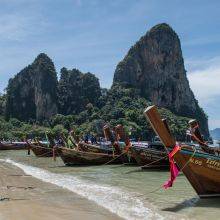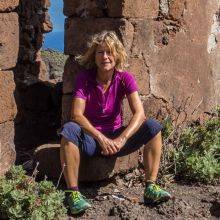When Is the Best Time
The Khao Sok is Thailand’s wettest region, with an annual rainfall of 3.500 mm. The reason is the limestone mountain range from north to south. It gets hit by the monsoons from the Andaman Sea and the Gulf of Thailand between late April and the end of November. Therefore, the driest months are December to April and the most popular ones as well.
Weather

Taking a refreshing bath
The dry season lasts from December to late April. However, showers can also occur in the dry season and especially in the rainforest. The hottest months with high humidity are March and April, with temps around 34°C. The rainy season starts in late April and lasts until the end of November. Most precipitation from May to July and from October to November.
Avoiding Crowds
It's pretty busy around the visitor centre, and it takes some time to purchase the entrance ticket for 300 Baht / roughly 8 € / 9 $. The ticket is valid for 24 hours. As soon as you start hiking deep into the jungle, the crowds thin out. At the beginning of the Ton Gloy Waterfall Trail, it's pretty crowded, but also along this popular hike, fewer people are along the trail after around an hour hiking.
Seasons in the Khao Sok Rainforest

- To experience the vivid rainforest, May is the best month.
- For birding, the monsoon season is the best time when birds spread out and the very best month is May when the mating season starts. The dry season is not recommended for birding.
- For hiking, the dry season might be the best time. The trails are slippery after heavy rainfall and some parts are closed during the rainy season.
- Rafflesia Kerrii is in bloom between January and March for about 5 days only. Very difficult to predict.
- More mosquitos during the rainy season and leeches are on the forest floor at least until November.
Best Months to Visit
Location and Tips

The Khao Sok National Park was established in 1980 to protect one of the oldest rainforests in the world and covers an area of 739 km2. It is famous for its karst limestone formations, caves, and the Rafflesia flower.
The Rafflesia, a giant red flower, the largest flower in the world. It's only roughly 5 days in bloom and you need to be fortunate to be at the Khao Sok at this specific time to see this unique flower. The Rafflesia is up to 80 cm big and smells awful like rotten meat. The reason for the smell the flower wants to attract flies for pollination. The flower was named after the British Sir Thomas Stamford Bingley Raffles, founder of the port city of Singapore. There is a special trail to see this flower. Picture attached to find the trail.

Green Pit Viper
The Khao Sok is home to a huge variety of wildlife. Some can be seen on several day trips especially in the north of the Cheow Lan Lake which was created in 1982 by the dam Ratchaprapha. The Khao Sok is home to 48 different species of mammals, more than 300 different species of birds and more than 30 species of bats.
Mammals
Elephants, tigers, leopards and clouded leopards, sun bears, tapirs, civets, deer, dusky langurs, gibbons, macaques, pangolins and much more, but most of them you will not spot.
Birds
First of all, famous for the different species of hornbills, species of kingfishers, crimson sunbird, blue-winged pitta, species of woodpeckers, bulbul, drongo, paradise flycatcher, black and red broadbill and more.
Hiking
Two marked trails which are easy to hike by yourselves start at the Information Center:
- San Yang Roi
The short trail is a narrow path all along the Sok River. - Tone Kloy Waterfall
The trail is 7 km one way to the Tone Kloy Waterfall and leads through the awesome rainforest. In the beginning, the trail is wide and quite busy. The track becomes more slippery and narrow from the ranger station onwards. From here the crowds thin out and very few people continue hiking. Several footpaths leading along the river. Watch the roots along the trail. We spotted view birds only, a venomous green pit viper and the shy Dusky Langurs also called spectacled leaf monkeys close to the ranger station. The huge group with three babies was feeding leaves and flowers.
Is a Guide Necessary?
Usually, yes, but in the Khao Sok National Park, check the motivation and experience of the guide first. Let him know what you would like to see and where you would like to hike to. If you book a guided tour at your hotel let them know what you want. Otherwise, it may happen that you don't get what you expected for a huge amount of money. IMO, you can walk some trails by yourself at your own pace, but the best option is a guided tour. We recommend a combined tour to Khao Sok and Cheow Lan Lake. This guarantees a much better experience of this truly beautiful rainforest.
Dusky Langur Facts

- The young ones are often bright orange but change the color when they are around three months old.
- Babys are frequently born from January to March.
- Unfortunately, they are near-threatened due to their habitat loss.
- They can be found only in Thailand, Myanmar, and Malaysia.
- An adult weighs around 6-7 kg.
- Dusky Langurs can get up to 30 years old.


There are plenty of accommodations around the Khao Sok National Park. At least spend three nights in the area, one for the Khao Sok, one day for Cheow Lan Lake, but there is so much more to explore. Chose the lodge or hostel close to the entrance of the park within walking distance. Check their payments first. Some don't accept credit cards just cash.
- The Khao Sok Riverfront Resort offers beautifully located cabins all with lots of privacy next to the river. We went swimming each afternoon and enjoyed the cold bath in the Sok river.
- The Khao Sok Jungle Hostel almost in front of the National Park entrance is the perfect location for the budget traveller.
- The Montania Lifestyle Hotel offers a high standard with breathtaking scenery and an excellent restaurant.































